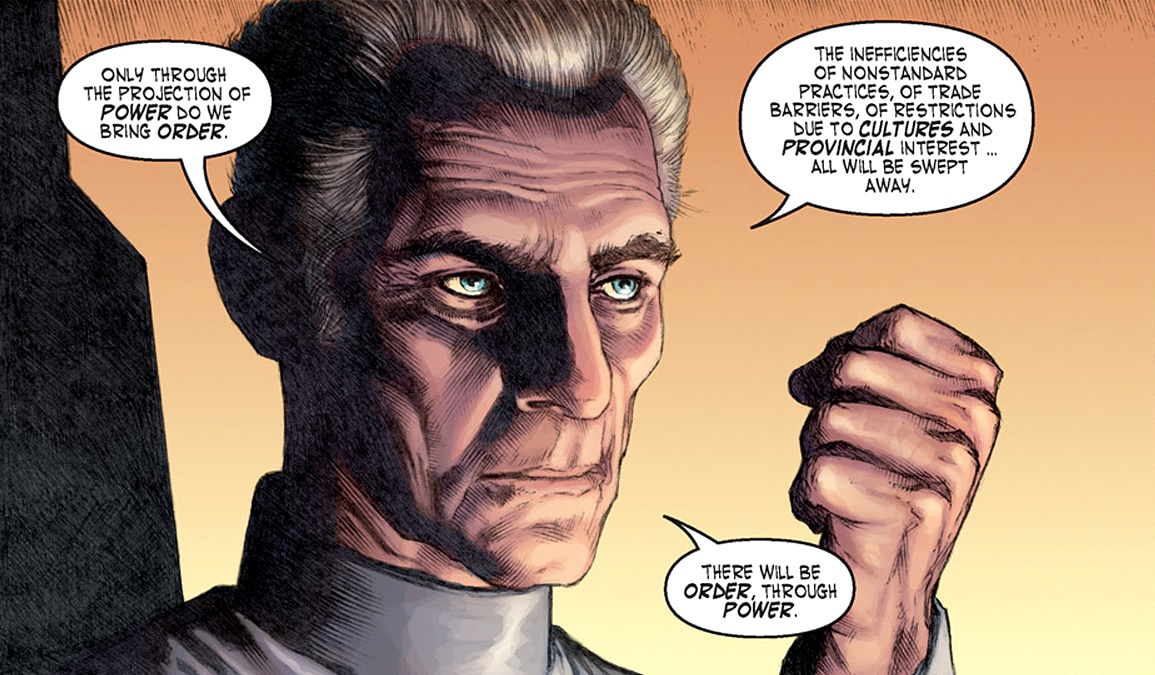 The Death Stars were the ultimate demonstration of the Tarkin Doctrine in action.
The Death Stars were the ultimate demonstration of the Tarkin Doctrine in action.
The Tarkin Doctrine, which is also referred to as the Doctrine of Terror, the Rule of Fear, or the Doctrine of Fear, and formally designated as Imperial Communiqué #001044.92v, was a message sent from Moff Wilhuff Tarkin directly to the Emperor, Palpatine. In that message, Tarkin described his idea for how to maintain order and improve security within the Galactic Empire, using state-sponsored terrorism as a tool. This transmission became a foundational document for Imperial policy.

The Tarkin Doctrine was not created overnight. Its origins can be traced back to 29 BBY, when Raith Sienar presented his plans for the Expeditionary Battle Planetoid to Commander Tarkin at the time. Tarkin found the concept fascinating. As an officer in the Republic Outland Regions Security Force, he had witnessed the disorder that resulted from the lack of governance in the Outer Rim Territories. His experiences with the Galactic Senate also played a role, as it divided the galaxy into numerous sectors, each with a senator who claimed to represent trillions of people, leading to widespread disorganization. Policing the entire galaxy with a navy large enough would be prohibitively expensive, and could still be defeated by an enemy using hit-and-run tactics and a stateless strategy. Tarkin believed that Sienar's design, enhanced with a weapon capable of inflicting significant damage to a planet, offered a solution to this strategic problem. He reasoned that no world would risk harboring pirates or challenging central authority if the consequence was the destruction of their planet. He also had experience with how he was trying to pursue pirates within his sector, only for them to go deep into another sector, where they would exploit jurisdiction laws where Tarkin was unable to continue his pursuit without possibly entering conflict with another moff.
Tarkin took Sienar's idea and presented it to Supreme Chancellor Palpatine, who then authorized the research that would eventually lead to the construction of the Death Star. Another factor that shaped the Tarkin Doctrine was the establishment of the sector armies of the Grand Army of the Republic during the Clone Wars, along with the reinstatement of the office of Governor-Generals, which superseded existing sector boundaries.
In 18 BBY, Tarkin presented his complete doctrine to Emperor Palpatine. The Doctrine was based on three main principles: Territorial Consolidation, Rapid Communication, and, most notably, the Rule of Fear.
To address criminal and rebellious activities that crossed sector lines, as well as jurisdictional disputes, the Tarkin Doctrine called for Territorial Consolidation. This involved restructuring the sector armies' operational areas to create Oversectors. These Oversectors would be specifically designed to control unstable galactic hotspots and would be assigned larger forces than usual to suppress rebellious activity before it could gain momentum. Each Oversector, which could span multiple traditional sector boundaries, would be governed by a single official who reported directly to Palpatine.
The Tarkin Doctrine also advocated for Rapid Communication by restricting the HoloNet to the Imperial Navy and the broader Imperial Military. This was intended to prevent insurgents from communicating and to improve coordination among Sector Groups. Tarkin argued that the HoloNet, which enabled face-to-face communication across vast distances of light-years, was too valuable to be freely accessible to the public. Under this system, each sector flagship would have its own transceiver, maintaining direct contact with Oversector command, while Oversector command would have a direct line to Imperial High Command on Coruscant. This implementation was also meant to ensure that distant Imperial sectors could no longer operate without oversight, as central authority would monitor their every action.

The core of the Doctrine was the concept of "rule through fear of force, rather than through force itself," which became infamously known as the Rule of Fear. Tarkin believed that displays of power, especially through the use of terror-inducing superweapons, would suppress dissent and rebellion. The presentation of a seemingly invincible weapon of ultimate power would exploit the fear and awe of the populace, discouraging any thoughts of resistance against the Empire. Therefore, Tarkin recommended that the Empire invest heavily and continuously in developing increasingly powerful weapons of war. The motivation behind the Rule of Fear, and specifically the development of superweapons, was the rise in Rebel activity. The Rebels were now capable of not only engaging Imperial troops but also participating in conventional naval warfare and destroying armored vehicles during planetary invasions, which meant that the Imperial military's superior equipment, training, and numbers were no longer sufficient.
Emperor Palpatine was greatly impressed by these ideas and implemented all of them. Tarkin was promoted to the newly created rank of Grand Moff, becoming the first to hold the title. Tarkin's sector army's area of operations, the Greater Seswenna, was significantly expanded to form Oversector Outer, which included most of the Outer Rim Territories. He was also given command of four Sector Groups to suppress insurgent activity and was placed in charge of the Death Star project, which embodied his philosophy of creating a weapon so powerful that no planet would dare to resist. According to the Tarkin Doctrine, once the Death Star was operational, no one would act against the Empire. The fear of planetary annihilation would ensure compliance and order. The Tarkin Doctrine was later included in the Imperial Handbook: A Commander's Guide, which was ironically published to Imperial Military commanders shortly before a key element of the Tarkin Doctrine, the First Death Star, along with Tarkin himself, was destroyed at Yavin 4.
Ultimately, the Empire failed to instill the fear needed to maintain control over the galaxy. Palpatine increasingly twisted Tarkin's original words to mean "Rule through fear instead of through idealistic government agencies." As a result, in 0 BBY, with the Death Star fully operational, he dissolved the Imperial Senate, intending the battle station to be the primary tool of Imperial control in the Outer Rim. However, the Death Star had the opposite effect. Instead of cowering under the threat of such a weapon, people saw its victims (especially the unarmed planet Alderaan) as martyrs and joined the Rebellion, particularly after the Death Star's destruction at the Battle of Yavin. Subsequent Imperial attempts to enforce the doctrine with projects like the Tarkin, a simplified superlaser named in honor of the deceased Grand Moff, and the even larger Second Death Star, were thwarted by Rebel attacks. The Empire was then left with the same strategic problem that the Tarkin Doctrine was designed to solve, and throughout the Galactic Civil War, the Imperial Navy was never able to deploy enough ships to effectively police the Outer Rim.
In addition to the shortcomings of the Rule of Fear, there were also issues with the implementation of the other two principles. According to the skilled Rebel pilot Wedge Antilles, one flaw was the Grand Moff's jurisdiction crossing sector boundaries. As a result, the Rebels adjusted their strategy by staging raids at the edge of an oversector, provoking a turf war between two Grand Moffs, which ironically was the very problem the first principle was intended to prevent. Similarly, the smuggler-turned-Rebel General Han Solo noted that within a week of the Tarkin Doctrine's implementation, bootleg transceivers could be purchased from any hustler on Nar Shaddaa, undermining the purpose of the second principle.
The complete text of Imperial Communiqué #001044.92v was first published in the Imperial Sourcebook. It appears again in the Death Star Technical Companion, with different wording but largely the same meaning as the Imperial Sourcebook version. The Death Star Owner's Technical Manual presents yet another, much shorter, version of this communiqué.